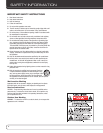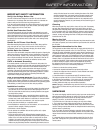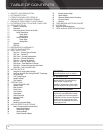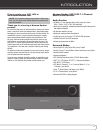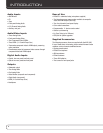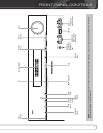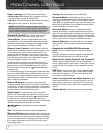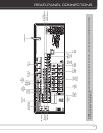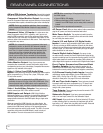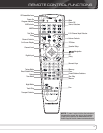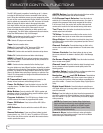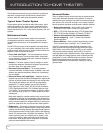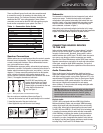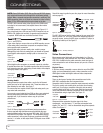
10
REAR- PAnEL COnnECTiOnS
AM and FM Antenna Terminals: Connect the included
AM and FM antennas to their respective terminals for radio reception.
Component Video Monitor Output: If you are using
one of the Component Video Inputs and your television or video display
is component-video-capable, connect these jacks to the video display.
NOTE: Due to copy-protection restrictions, there is no output
at the Component Video Monitor Outputs for copy-protected
sources.
Component Video 1/2 Inputs: If a video source has
analog component video (Y/Pb/Pr) capability, and if you are not
using an HDMI connection, connect the component video outputs
of the source to one of the sets of component video inputs. Do not
make any other video connections to that source. These inputs may
be assigned to any source.
NOTE: It is not possible to have no component video input
assigned to a source, as the AVR 1600 does not transcode
composite video source signals to the component video for-
mat. Thus, if a signal is present at the input assigned to the
source, and you have connected the source device to the
composite video input, you will not see the correct picture
unless you turn off the device connected to the component
video input, or assign the other component video input to the
source.
Video Monitor Output: If any of your sources use
composite video connections, connect this monitor output to the
corresponding input on your video display. Composite video source
signals are only available at this output.
Video 1, Video 2 and DVD Audio/Video
Inputs: These jacks may be used to connect your video-capable
source components (e.g., Blu-ray Disc
™
player, DVD player, cable
TV box) to the receiver.
NOTE: If a source is equipped with an HDMI output, it is
preferable to connect it to one of the AVR’s HDMI Inputs. If the
source does not have an HDMI output, use its component or
composite video output, and make a separate audio connection.
Video 1 Audio/Video Outputs: These jacks may be
used to connect your DVR, VCR or another recorder.
HDMI Inputs and Output: HDMI (High-Definition
Multimedia Interface) is a connection for transmitting digital audio
and video signals between devices. Connect up to three HDMI-
equipped source devices to the HDMI inputs using a single-cable
connection.
When you connect the HDMI Output to your video display, the
AVR 1600 will automatically transcode component video source
signals to the HDMI format, but they will be passed through at
the original resolution and will not be scaled. The AVR’s on-screen
menus are visible when the HDMI Output is used, but only at
480i resolution. The main video source will not be visible.
NOTE: When connecting a DVI-equipped display to one of
the HDMI Outputs:
• Use an HDMI-to-DVI adapter.
• Make sure the display is HDCP-compliant. If it isn’t, do not
connect it to an HDMI Output; use an analog video connection
instead.
• Always make a separate audio connection.
AC Power Cord: After you have made all other connections,
plug the AC power cord into an unswitched wall outlet.
Main Power Switch: This mechanical switch turns the
power supply on or off. It is usually left on, and cannot be turned
on or off using the remote control.
Coaxial 1/2 and Optical 1/2 Digital Audio
Inputs: If a source has a compatible digital audio output, and
if you are not using an HDMI connection for audio for the device,
connect it to one of these jacks to hear digital audio formats, such
as Dolby Digital, DTS and linear PCM. Use only one type of digital
audio connection for each source.
Coaxial Digital Audio Output: If a source is also
an audio recorder, connect the Coaxial Digital Audio Output to the
recorder’s matching input for improved recording quality. Only PCM
digital audio signals are available for recording. Both coaxial and
optical digital audio signals are available at this Digital Audio Output.
Front, Center, Surround and Surround Back
Speaker Outputs: Use two-conductor speaker wire to
connect each set of terminals to the correct speaker. Remember
to observe the correct polarity (positive and negative connections).
6-/8-Channel Analog Audio Inputs: Connect the
multichannel analog audio outputs of a non-HDMI player (DVD-
Audio, SACD
™
, Blu-ray Disc or HD-DVD, or any other external
decoder) to these jacks. See page 25 for more information.
CD and Tape Audio Inputs: These jacks may be used
to connect audio-only source components (e.g., CD player, tape
deck). Do not connect a turntable to these jacks unless you are
using it with a phono preamp.
Tape Outputs: These jacks may be used to connect a CDR
or another audio-only recorder.
Subwoofer Output: If you have a powered subwoofer
with a line-level input, connect it to the Subwoofer Output.
AUX Input: Enjoy audio from an iPod (not included), CD player
or other portable player by connecting its headphone jack to this
input using a 1/8” stereo mini-plug cable (not included). Video and
still-image playback are not available at this input.



